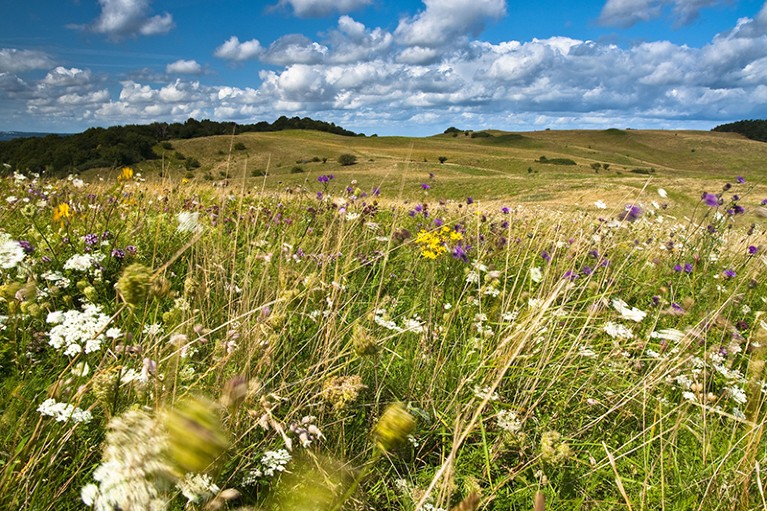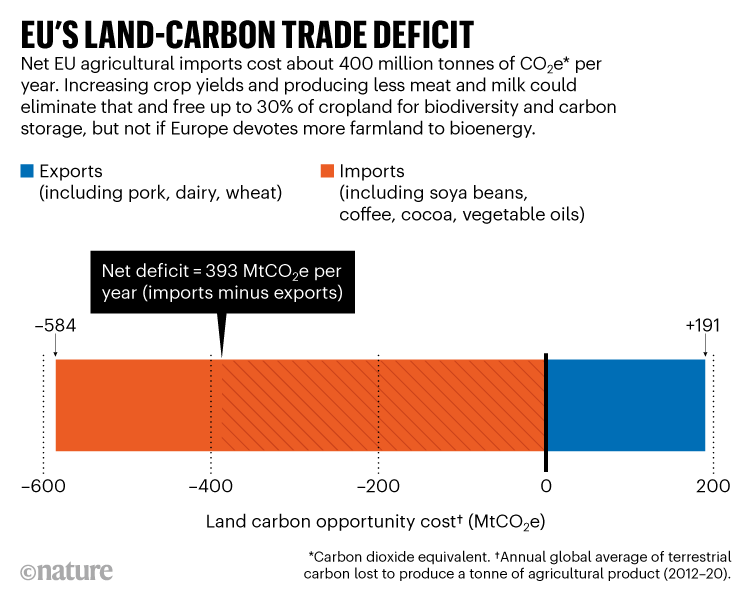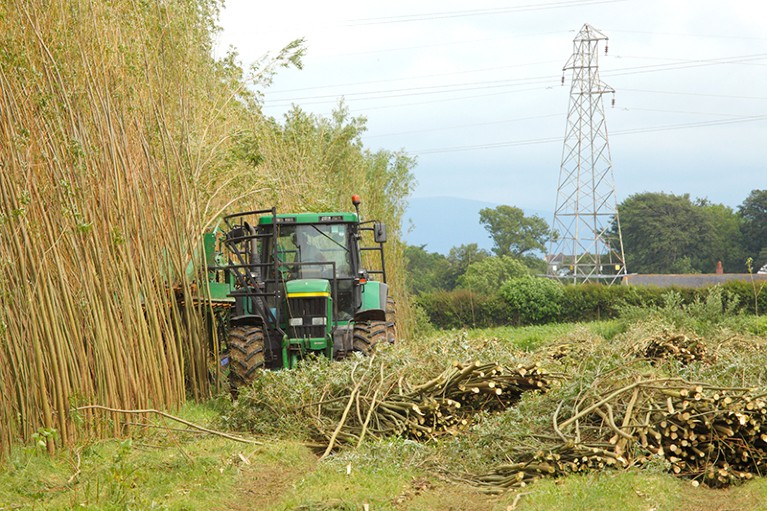Nearly all strategies to meet climate targets or preserve global biodiversity require the world’s agricultural land area to be held at current levels or reduced. More precisely, the world must decrease its ‘land carbon footprint’, which is the quantity of carbon lost from native habitats to supply agricultural products and wood. But rising populations and incomes put the world on track to require 40–60% more crops and 70% more milk and meat in 2050 than in 20101. Even factoring in higher yields, models project that cropland will expand by 100 million to 400 million hectares (Mha) globally over this period1,2. Indeed, remote sensing of recent growth rates3 puts the world’s cropland on track to consume 450 million more hectares over this period, an area 1.5 times the size of India.
To meet the challenge, countries must do more to maintain or reduce their land carbon footprints. They can do so by boosting crop and livestock yields and by reducing demand, particularly for products that require a lot of land to produce, such as meat.
The world must also rapidly reduce its fossil-fuel emissions, with the European Union playing a key part. The bloc is on the cusp of enacting its ambitious ‘Fit for 55’ plan, designed to reduce greenhouse-gas emissions by 55% by 2030, relative to 1990 levels. New energy laws are at its centre: a revised directive to increase renewable energy to 40–45% by 2030, tighter caps on emissions from factories and power plants, and requirements that aviation and shipping industries shift to alternative fuels. The EU is also finalizing laws that it says will increase land-based carbon storage and biodiversity in Europe and reduce deforestation abroad.Europe’s Green Deal offshores environmental damage to other nations
Unfortunately, although other parts of the plan should reduce emissions, the broad rules assigning climate benefits to bioenergy will undermine carbon storage and biodiversity both in Europe and globally, by expanding Europe’s outsourcing of agricultural production to other countries. By treating biomass as ‘carbon neutral’, the rules create incentives to harvest wood and to divert cropland to energy crops, regardless of the consequences for land-based carbon storage.
The threats to food supply from the war in Ukraine highlight how land-use choices matter. We calculate that cutting 85% of Europe’s use of biodiesel and half of US and European grain ethanol could free up enough crops to replace all Ukraine’s vegetable oil and grain exports (see Supplementary information, which includes data, methodology and further references for all our calculations).
Here we analyse these trade-offs and describe how Europe can, with reforms, take a more environmentally friendly path.
Reducing Europe’s footprint
Recent environmental improvements might give the impression that Europe has ‘spare’ land available for growing more bioenergy crops. However, that is a misperception created by Europe’s vast historical land carbon footprint. Although the area of European farmland has declined enough for forest cover to increase from 25% of land in 1900 to 35% today (according to the HILDA model4), still more than half of Europe’s past forests are gone. And most today are managed to produce wood rather than to provide natural carbon storage or biodiversity. Yet the reasons behind this forest recovery are instructive for how to reduce land carbon footprints. They include boosting crop and livestock yields and slowing population growth. The decline in traditional bioenergy from reductions in the numbers of working animals has also reduced the need to devote vast areas to pasture and feeds.
Climate strategies require that Europe decrease its currently large land carbon footprint. This is feasible. Europe’s population is likely to remain stable or decline over the next decade and beyond, and meat consumption has probably peaked. Because yields should continue to grow, the same models that project vast cropland expansion globally in 2010–50 typically project that the area of European cropland will reduce by 10 Mha to 50 Mha. Without European reductions, global cropland is therefore likely to expand even more.
To stop this expansion, Europe must reduce its land carbon footprint even more by reducing its meat and milk consumption2,5. The average European consumes four times more meat and milk than does the average person in poorer countries, which will hold 60% of the global population in 20501. Milk and meat have large footprints, and consumption in these countries is likely to grow. Reductions in Europe are necessary to compensate for this growth elsewhere.
Outsourcing and carbon costs
Europe’s outsourcing of agricultural land might also contribute to this misconception of spare land at home. Although EU nations expanded their own forests by 13 Mha between 1990 and 2014, the region’s agricultural imports led to an estimated 11 Mha of deforestation outside Europe, mainly in the tropics6. Another study7 found that deforestation emissions account for one-sixth of the emissions of the average European diet.
Although these studies trace Europe’s imports directly to recent deforestation, a fuller measure of Europe’s footprint should take into account foreign agricultural land used to supply the continent (regardless of its conversion date), all of which contributes to a reduction in carbon storage and biodiversity. And the calculations should credit Europe for land ‘saved’ abroad by its food exports.

Combined, we find that Europe appropriates 1 hectare of cropland abroad for each 4 hectares of cropland in Europe.
To estimate the carbon costs of this outsourcing, we apply ‘carbon opportunity costs’ to European imports and exports. These estimate the quantity of carbon lost per year to generate one tonne of each different crop or livestock product, divided (or ‘amortized’) by roughly 35 years8. They indicate how much carbon could be stored globally, on average, if the world consumed one less tonne of that product.
Between 2012 and 2020, we find that Europe has run a large ‘land-carbon trade deficit’ of around 400 million tonnes of carbon dioxide equivalent (MtCO2e) per year (see ‘EU’s land-carbon trade deficit’).

This deficit exceeds the roughly 300 MtCO2e of annual carbon sequestration that the EU claims from its domestic forests (after factoring in 100 MtCO2e of losses, mostly from degrading peatlands). According to the principles of the Kyoto Protocol, Europe should not take credit for most of this ‘forest carbon sink’ anyway; it mainly reflects the fertilizing effects of higher CO2, warmer weather and regrowth of forests established before 1990, all of which are independent of mitigation efforts.
Thus, rather than Europe having spare land or wood to supply additional bioenergy or other consumption, climate strategies require the bloc to ‘give back’ land and carbon either to nature or to supply others.
The opportunity
Fortunately, Europe can achieve a more environmentally friendly land future. We estimate (using the Globagri model1) that Europe could free up around 17 Mha of cropland by 2050 while nearly eliminating its land-carbon trade deficit. To do so, Europe must maintain yield gain trends (see Table S1) and modestly reduce biofuel consumption to 2010 levels (see Figures S2 and S3).
If Europe also reduced its per capita consumption of animal products by 17% — its equitable share of a 10% global reduction — it could free up almost 30% (28 Mha) of its cropland, an area nearly the size of Poland (see Figures S2 and S3). Europe could use this land to benefit climate and biodiversity in three ways.
First, Europe could grow more food, export more or import less, and turn its land-carbon trade deficit into a surplus. Owing to higher yields, global exports from European countries require less land and sacrifice less carbon storage than does production in most other countries. Likewise, each hectare saved in the tropics generally has more carbon and biodiversity than does a hectare restored in Europe.
Second, the EU could store more carbon in Europe. Rewetting the region’s drained peatlands is a priority, because they emit at least 100 MtCO2e per year — possibly twice that amount. Preserving older forests from harvest is another priority for both carbon and biodiversity. Planting fast-growing trees on agricultural lands could replace the foregone wood supply.

Third, Europe could restore habitats. Approximately 30–70% of assessed populations of most major European taxa have a conservation status of ‘poor’ or worse (see Table S2). Biodiversity priorities include buffering the remnant habitats on which rare species survive, and preserving the 20 Mha to 30 Mha of diverse, semi-natural grasslands.
Europe could reasonably choose a mix of these goals for its land future, but they all require a smaller footprint.
Bioenergy and land
Although the European Commission says otherwise, its Fit for 55 plan sacrifices carbon storage and biodiversity for extensive bioenergy. Its own modelling predicts that yearly use of bioenergy will more than double between 2015 and 2050, from 152 million to 336 million tonnes of oil equivalent. That requires a quantity of biomass each year that is twice Europe’s present annual wood harvest, and eight times the portion of that harvest used for bioenergy today.
Modelling by the commission also projects large effects on forests and land use: by 2050, Europe will devote 22 Mha of cropland to energy crops, or roughly 20% of cropland, and import four times as much wood for bioenergy. It will also lose 17 Mha of cropland for food and feed. Roughly half of Europe’s semi-natural grasslands will disappear to generate energy crops or host intensively managed forests. The commission probably underestimates these effects on land and forest felling by stating that bioenergy will use 2.5 times the maximum available forest residues estimated by other sources. Overall, the plan means less habitat and carbon storage in Europe, and continued or greater outsourcing of Europe’s footprint.Fuel crisis: slash demand in three sectors to protect economies and climate
A proposed EU anti-deforestation law will not halt these effects. This law will prohibit imports of some commodities (such as soya beans and beef) produced on newly deforested land. But as long as Europe’s use of existing agricultural land in other countries is maintained or grows, global agricultural lands must expand unless other countries reduce their footprints by even more to compensate.
Nor can a proposed nature-restoration law shore up Europe’s biodiversity without even more outsourcing, if expansion of bioenergy leaves no land to restore as native habitats. Other bioenergy effects are also harmful. Although energy crops provide more habitat for common species than do annual crops, the loss of semi-natural grasslands means less habitat for many rare plants, butterflies and birds. Removal of almost all wood-harvest residues from forests contradicts the priority to leave more dead wood for many rare species.
Carbon accounting error
Driving the push for bioenergy is the belief that it will reduce greenhouse-gas emissions by replacing fossil fuels. But the EU’s carbon accounting ignores the consequences of increased land use because the energy laws treat bioenergy as ‘carbon neutral’. Although greenhouse gases from the fossil fuels used to produce biofuels count as emissions, carbon stored in the biomass and emitted by burning or refining it does not.
Crucially, this assumption ignores the opportunity costs of agricultural land and wood. The typical justification is that the carbon emitted by burning biomass is offset by the carbon absorbed by growing the plants. But land is required to grow plants. Using cropland for energy crops means this land cannot produce food, which helps the climate by reducing the need to convert other lands. More wood for bioenergy means less carbon in forests. Land is not ‘free’.
Fit for 55 proposes some restrictions on biomass production. It caps biofuels from food and feed crops at near 2020 levels and excludes them from shipping and aviation fuel targets. Biomass loses its carbon-neutral status if it is produced on land gained from newly cleared forests or is harvested from some primary forests. But energy crops grown on existing agricultural land and wood harvested from most of the world’s forests still count as carbon neutral.
The commission says that strengthened climate rules on land use compensate for this problem. These rules require that countries modestly expand their forest carbon sinks and correct some accounting abuses. If bioenergy growth leads to more wood harvest in Europe, the commission argues correctly, the emissions should be reported somewhere in Europe’s land-sector balance sheet.To ease the world food crisis, focus resources on women and girls
But distorted incentives persist for the simple reason that biomass remains carbon neutral to energy users. Factories, power plants, airlines and ships will receive climate credit for replacing fossil fuels with biomass regardless of the real effect on carbon storage, either in Europe or abroad. If a Danish power plant imports and burns Romanian wood, the rules could require Romania to make more mitigation efforts to compensate for the reduced carbon storage. Regardless, the Danish power plant still has incentives to do so, despite increasing carbon in the atmosphere. And if new land-use rules lead Romania and other EU countries to restrict wood harvesting to preserve their carbon stocks, the bioenergy rules will drive even more outsourcing.
Although bioenergy can reduce net emissions over long time frames, the consequence either of harvesting more wood or diverting cropland to bioenergy is likely to be increased carbon in the air for decades. The commission’s published Forest Strategy, in a single sentence buried in the middle of a long document, agrees with the overwhelming literature that harvesting stem wood for bioenergy increases atmospheric carbon for decades, even when factoring in reduced fossil-fuel use9. Diverting a hectare of European cropland to energy crops is also likely to increase carbon in the air for decades when compared with either saving one hectare of forest or savanna abroad, or even reforesting a hectare in Europe10.
Lessons and solutions
A climate planning process such as the Fit for 55 strategy highlights the error of treating biomass as carbon neutral and therefore land as free. The plan allocates resources, including land, among competing uses to reduce emissions. Ignoring land’s alternative ‘carbon value’ when diverting land to bioenergy guarantees its inefficient use.
The simplest solution is for the EU to stop treating biomass from energy crops and wood harvests as carbon neutral. The European Parliament adopted an amendment to freeze the quantity of woody biomass that counts as ‘low carbon’ at each EU country’s 2020 level of use. If this rule survives negotiations with the Council of the EU, it could limit the damage.
Unfortunately, the parliament failed to bring all energy crops under the same cap applied to biofuels derived from food and feed crops, despite their similar effects on food production and cropland. Unless the EU fixes this problem, the more it restricts fossil carbon, the more it will encourage diversion of cropland to energy crops and outsource its food production.
The best solution is to incorporate the ‘carbon opportunity cost’ of land use into the accounting of emissions from bioenergy in all climate and energy laws. This cost can be measured simply as the carbon that could otherwise be stored by regrowing native vegetation. A superior approach would use carbon opportunity costs, as we have done here, to calculate the average carbon cost to reproduce the same food elsewhere. This approach does not require a switch to consumption-based accounting but recognizes that land use has an opportunity cost, which should be factored into the life-cycle analyses of bioenergy used by the EU.
Source : Nature















